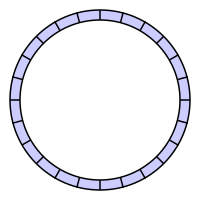Circular buffer

A circular buffer is like a plate with different compartments. Imagine you have a plate with multiple sections on it. You put in food in each section and when you finish eating from the first section, you start eating from the second one, and then the third one, and so on until you eat from all compartments. Once you finish eating from the last compartment, you go back to the first one again and start over.
In a similar manner, a circular buffer is a space where you can store data in the form of a sequence or list, and then read it in a loop. It is called a circular buffer because reading data from it creates a circular pattern or loop. It is like a circle where you start at one point and, after reading all the data, end up at the same point, ready to read the data again.
One example of using a circular buffer is in an audio recording device. The device stores audio data in a circular buffer. The buffer is split into small blocks, each of which contains a short duration of audio data. When the buffer is full, the device starts overwriting the oldest block of data with new data.
When the device detects that someone wants to listen to the audio, it plays the audio data from the buffer, and once it finishes playing the last block, it starts reading from the first block again. This cycle continues until the user stops playing the audio.
In summary, a circular buffer is a sequence or list of data that stores and reads data in a loop, like a circle. It is useful in many applications where you need to store and process data that repeats itself over time.
In a similar manner, a circular buffer is a space where you can store data in the form of a sequence or list, and then read it in a loop. It is called a circular buffer because reading data from it creates a circular pattern or loop. It is like a circle where you start at one point and, after reading all the data, end up at the same point, ready to read the data again.
One example of using a circular buffer is in an audio recording device. The device stores audio data in a circular buffer. The buffer is split into small blocks, each of which contains a short duration of audio data. When the buffer is full, the device starts overwriting the oldest block of data with new data.
When the device detects that someone wants to listen to the audio, it plays the audio data from the buffer, and once it finishes playing the last block, it starts reading from the first block again. This cycle continues until the user stops playing the audio.
In summary, a circular buffer is a sequence or list of data that stores and reads data in a loop, like a circle. It is useful in many applications where you need to store and process data that repeats itself over time.
